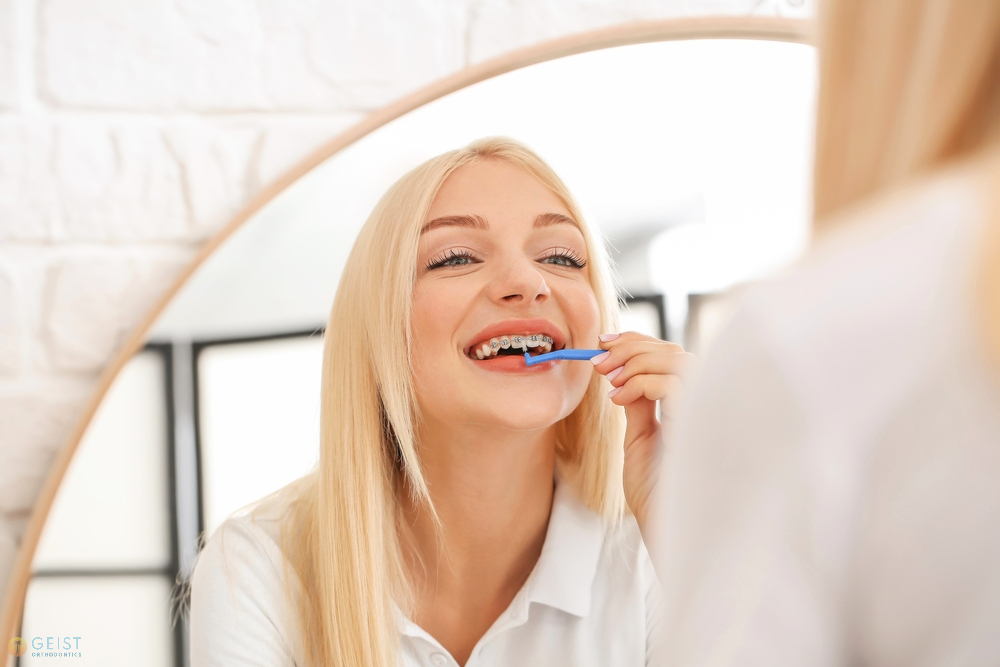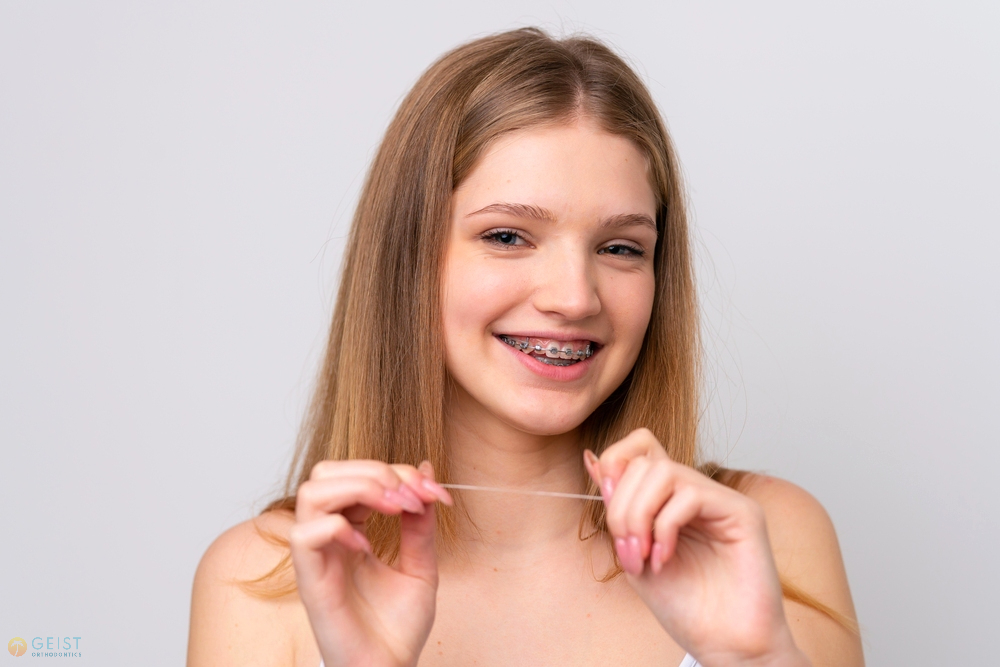
How to Floss with Braces in Indianapolis, IN
Are you wondering how to floss with braces in Indianapolis, IN? You’re not alone. Cleaning around brackets and wires can feel tricky at first. But with the right flossing tools and simple techniques, you can master it in no time. Keep reading to discover expert tips, step-by-step guidance, and the best tools recommended by orthodontists at Geist Orthodontics to make flossing with braces easier and more effective.
Why Flossing with Braces Matters
Braces are great for straightening teeth, but they make cleaning challenging. Food particles and plaque often get trapped in small spaces around braces and wires. If not removed, this can lead to tartar, tooth decay, and gum disease. Flossing with braces clears out this buildup and keeps your gumline and teeth clean. Clean teeth also help braces work more efficiently, reducing the risk of complications.
The Best Tools for Flossing with Braces
Flossing with braces becomes easier when you use the right tools. Here are some of the most helpful options:
Floss Threaders
A floss threader acts like a needle, helping you thread dental floss under braces wires. It makes cleaning between your teeth much simpler. Many orthodontists, including Geist Orthodontics in Indianapolis, IN, recommend these to patients as part of their care routine.
Water Flossers
A water flosser (or oral irrigator) sprays a jet of water between teeth and around brackets. It’s ideal for people with sensitive gums or those who find threading regular floss difficult. By using a water flosser, you can clean hard-to-reach areas quickly and without discomfort.
Superfloss
Superfloss has both stiff and spongy sections. The stiff part helps thread under wires, and the soft part removes plaque and debris around braces. This is a great option for cleaning tight spots. It’s designed for comfort and ease, making it a good choice for anyone new to braces.
Interdental Brushes
An interdental brush, sometimes called a proxabrush, is a small, bristled tool that fits between teeth. It’s excellent for cleaning under wires and removing food particles stuck in tight spaces. These brushes are handy for use after meals or snacks. They’re also reusable and easy to rinse clean, making them great for on-the-go care.
Floss Picks
Floss picks include a handle with a small piece of dental floss. These are simple to use, especially for patients who find traditional floss hard to handle. They’re great for quick cleaning when you’re short on time. You can keep a few in your bag or car to use anywhere during the day.
Where to Find These Tools
You can buy these flossing tools, like floss threaders, water flossers, and interdental brushes, at your local drugstore or online retailers. Most of them are affordable and easy to find in dental care sections. Your orthodontist may also offer samples or recommend brands that work best for your needs.
A Simple Step-by-Step Guide
Flossing with braces takes a little extra time, but the following steps will make the process easier:
Step 1: Prepare Your Floss
Cut about 18 inches of floss. Use a floss threader to guide the floss under the wire of your braces. Hold both ends tight to keep the floss steady. Move slowly so you don’t pull or bend the wire while threading it through.
Step 2: Clean Around Each Tooth
Wrap the floss in a “C” shape around one tooth. Gently slide it up and down to remove debris from the gumline. Be careful not to snap or pull too hard, as this could irritate your gums or damage your braces.
Step 3: Use a Water Flosser for Tough Spots
For extra cleaning, use a water flosser. Direct the water stream at tight spaces around brackets, wires, and the backs of teeth. Adjust the pressure based on your comfort level or for sensitivity.
Step 4: Brush Your Teeth
After flossing, brush your teeth with a soft toothbrush and fluoride toothpaste. Focus on cleaning around brackets and wires using gentle, circular motions. Rinse with fluoride mouthwash for extra protection against tooth decay.
Flossing Tips Based on Braces Types
Different braces require slightly different flossing approaches:
- Metal Braces: Use plenty of floss threaders to clean thoroughly around metal brackets.
- Clear Braces: Be gentle to avoid damaging these delicate braces.
- Lingual Braces: Braces placed behind your teeth are harder to clean. Use a water flosser or interdental brush for best results.
- Self-Ligating Braces: These braces have fewer parts but still require regular cleaning to prevent plaque buildup.
Common Flossing Challenges and Solutions
Flossing with braces isn’t always easy, especially at first. Here’s how to overcome common challenges:
Sensitive Gums
Flossing sensitive gums can feel uncomfortable at first. Rinse with warm saltwater after flossing to soothe them. Over time, your gums will adjust and become healthier.
Hard-to-Reach Spaces
For areas blocked by braces or wires, use a water flosser or super floss to clean these spots thoroughly. Likewise, Dr. Jason Berk, a respected orthodontist in New York, NY, recommends these tools for patients who struggle with traditional flossing, as they provide a gentle yet thorough clean around braces and protect sensitive gums.
Difficulty with String Floss
If managing traditional floss takes too much time, use floss picks or pre-threaded flossers. They’re quicker and easier to navigate around braces. These tools are simple to hold and less likely to get tangled. Keeping them handy can help you stay on track with your daily cleaning routine.
Professional Cleaning Tips from Geist Orthodontics
At Geist Orthodontics, we help make your orthodontic care as smooth as possible. Our team provides:
- Custom Cleaning Kits: Starter packs with everything you need, including flossers and other tools.
- Flossing Tips and Guidance: Hands-on demonstrations of effective flossing methods.
- Expert Support: Solutions for challenges like gingivitis, tight areas, and tooth decay prevention.
Oral Hygiene Post-Braces
Even after your braces come off, you should stick to healthy dental hygiene habits to protect your smile:
- Clean Your Retainer: Rinse and brush your retainer daily to avoid plaque buildup.
- Floss Daily: Keep flossing every day to remove leftover debris.
- Brush Thoroughly: Brush twice a day with fluoride toothpaste to maintain strong teeth and a clean gumline.
Ready to Improve Your Braces Care?
Flossing with braces can feel like a challenge at first, but with the right tools and a little patience, it quickly becomes part of your routine. At Geist Orthodontics, we’re here to help you maintain a healthy, confident smile throughout your orthodontic treatment. Book an appointment today at Geist Orthodontics in Indianapolis, IN, and let us guide you on your path to better braces care.
About The Authors
Dr. Julian Davila – Orthodontist in Indianapolis, IN
Dr. Jason Berk – Orthodontist in New York, NY
Frequently Asked Questions
Is it better to floss at night or in the morning?
Flossing at night is usually best since it removes food and plaque from the day before you sleep. But if mornings fit your routine better, that’s fine too. The key is to floss daily.
How can I tell if I’m flossing correctly?
You’re flossing correctly when the floss glides with gentle resistance, wraps around each tooth in a C-shape, and moves up and down. A soft squeak is a good sign, and slight bleeding at first is normal but should get better with regular flossing.
Does flossing speed up braces?
Flossing won’t speed up your braces, but it keeps your teeth and gums healthy. This helps your treatment stay on track, prevents plaque and food buildup, and makes your braces more effective for a healthier smile.

